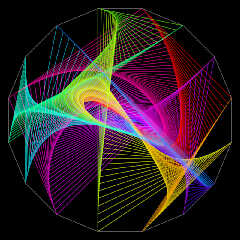|
 |
The yuqk fork returned to truly random jitter where the default of
jitter is off rather than the official V3.7 onward POV-Ray code where
antialiasing (AA) methods 1 and 2 jitter is always on - and any
randomness is predictive, but not purely gridded.
Further, it allows the jitter-ing to bounce outside the pixel - or bleed
into adjacent pixels - where the jitter amounts are >1.0. This ability
has thus far been called 'big jitter'.
I've now had some years playing with the 'improved jitter' in the yuqk
fork and while the yuqk fork is certainly more flexible, the results are
not always better depending upon the measure of goodness.
Using the Pursuit Curve code from Kurtz le pirate which was recently
posted on the POV-Ray forums, I've made an attempt to better formalize
some rough AA rules for using random/big jitter. See those rules below.
I've added to my yuqk fork to do list some ability to specify a minimum
recursive AA depth in addition to the maximum one. Thinking the options
and flag would be Antialias_Min_Depth=n and +RMn, respectively.
The 'lines' in the attached image have been fattened with a big jitter
rather than by increasing the radius of the cylinders. I believe this
will lead to better looking thumbnails for images of this type - FWIW.
Bill P.
==============================
October 31, 2023
1)
--
Shooting more rays and scaling smaller almost always leads to better
looking images. This can be accomplished by rendering much larger images
and scaling them down, or one can force more rays to be shot with AA, by
setting the threshold to 0.0.
2)
--
Though random / big jitter only applies to AA methods 1 and 2, All three
AA methods in v3.8 and beyond lack a means to force a minimum 'depth' or
number of rays be shot - prior to invoking adaptive AA. This is a
serious shortcoming where resolving detail is the measure of goodness.
In modes 1 & 2 you can set the AA threshold to 0.0, but then the
recursion depth is all that limits the number of rays shot.
3)
--
If trying to 'see' fine detail, where using, say, '+a0.01 +am2 +r3' it
is the case that dropping back one recursive depth with zero threshold,
'+a0.0 +am2 +r2', is often a win in both performance and result. This AA
depth fall back with a zero threshold, typically, works sooner in
resolving detail (at less depth), with random / big jitter.
4)
--
Using yuqk's random / big jitter will frequently see fine detail at
lower AA recursion depths - if the AA threshold is 0.0 (if a minimum
number of rays beyond the initial 'sample corners' is shot). However, at
low recursive depths the overall result is noisier due some of those
rays also more often missing the detail. In other words, at lower
recursive depths (minimum number of rays shot) the intensity of the fine
detail will more universally fluctuate.
5)
--
Where the number of rays is higher the random / big jitter leads to
better images faster than just rendering large with AA modes not having
random / big jitter. As the number of rays shot grows still more, having
a random / big jitter capability matters less and less. Aside: There is
a slight dimming of detail as the number of rays grows for mostly the
same reason the fluctuation in intensity shows up in (4).
6)
--
There are recommended maximum big jitter amounts for methods 1 and 2
depending on recursion depth. Using a big jitter value (jitter > 1.0),
but smaller than this recommended maximum, somewhat often, leads to a
better result with respect to resolving detail and the smoothness of the
resultant detail.
7)
--
There are a non-trivial number of reasons AA might quit earlier than
we'd like due used features having their own adaptive mechanisms.
8)
--
Big jitter allows for additional effects beyond more traditional AA.
9)
--
Depending on the particular scene, alignment of pixels with detail - and
desired results - the rules above will apply more, or less well. YMMV.
Post a reply to this message
Attachments:
Download 'courbesdepoursuite_c.jpg' (281 KB)
Preview of image 'courbesdepoursuite_c.jpg'

|
 |




![]()